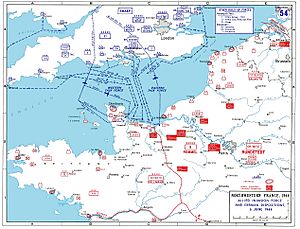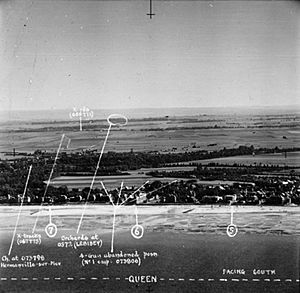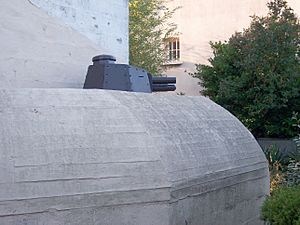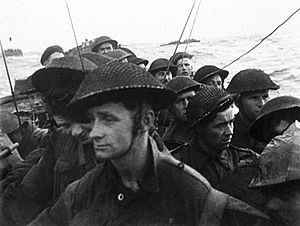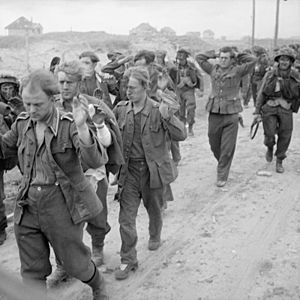Sword Beach facts for kids
Quick facts for kids Sword |
|||||||
|---|---|---|---|---|---|---|---|
| Part of Normandy landings and the Battle for Caen | |||||||
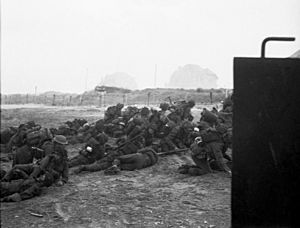 British infantry waiting to move off Queen Beach, SWORD Area, while under heavy enemy fire, on the morning of 6 June |
|||||||
|
|||||||
| Belligerents | |||||||
|
|||||||
| Commanders and leaders | |||||||
| Strength | |||||||
| 28,845 223 tanks |
8 infantry companies (716th Infantry Division) 9,790 124–127 tanks 40 assault guns (21st Panzer Division) |
||||||
| Casualties and losses | |||||||
| 683 casualties | unknown casualties 40–54 tanks lost 6 bombers destroyed |
||||||
Sword Beach was one of the five main landing areas during the Normandy landings on D-Day, June 6, 1944. This huge operation, called Operation Overlord, was when the Allies invaded German-occupied France. Sword Beach was the easternmost landing site. It stretched about 8 kilometers (5 miles) from Ouistreham to Saint-Aubin-sur-Mer.
The British Army was in charge of taking Sword Beach. They had help from the British Royal Navy and ships from Poland, Norway, and other Allied countries. These ships helped transport troops, clear mines, and bombard German defenses.
Sword Beach was the closest landing site to Caen, a major city about 15 kilometers (9 miles) away. The landings went well, and not many Allied soldiers were lost. However, getting off the beach was slow because of traffic and strong German resistance. The only major German tank counter-attack on D-Day happened here, which stopped the Allies from reaching Caen right away.
Contents
Why D-Day Happened: The Background Story
After France was taken over by Nazi Germany, British Prime Minister Winston Churchill promised to free the occupied countries. The Allies, including the United States and Britain, decided to open a "Second Front" in Europe. This would help the Soviet Union, who were fighting Germany on the Eastern Front.
Early plans for an invasion in 1942 and 1943 were put on hold. In August 1942, Canadian and British forces tried a landing at Dieppe. This was a test to see if a cross-channel invasion was possible. It ended badly, with many soldiers killed or captured. This taught the Allies important lessons about planning such a large attack.
The Allies then focused on fighting in North Africa and invading Sicily and Italy. These campaigns gave them valuable experience in landing troops from the sea and fighting inland. By 1944, they were ready to return to France.
Choosing Normandy for the Invasion
The Normandy beaches were chosen for the invasion, which was set for June 5, 1944. The British Second Army was tasked with landing between the River Orne and Port en Bessin. Their main goal was to capture the city of Caen. They also needed to protect the left side of the United States First Army, which was landing further west.
Capturing Caen was important because it would be a good starting point for further attacks. The entire operation, called Overlord, would be the largest sea invasion in military history. Bad weather and other problems delayed D-Day until June 6, 1944. Allied commanders, like Dwight D. Eisenhower and Bernard Montgomery, hoped to take Caen on the first day.
Planning the Attack: Allied Strategy
The Normandy coastline was divided into many sections, each with a special code name. Sword Beach was on the eastern side. These sections were further divided into smaller beaches, identified by colors like Green, Red, and White.
The British Second Army was in charge of the British and Canadian landings. Lieutenant General John Crocker's I Corps was assigned to take Sword Beach. Major General Tom Rennie's 3rd Infantry Division had the job of assaulting the beaches and capturing Caen.
Who Landed on Sword Beach?
The 3rd Infantry Division was supported by many other units. These included the 27th Independent Armoured Brigade with its tanks, and the 1st Special Service Brigade which included Free French Commandos. Special Royal Marine commandos, artillery, and engineers also joined them.
The 3rd Infantry Division's main goal was to push towards Caen, about 12 kilometers (7.5 miles) from Sword. They also needed to meet up with the 6th Airborne Division paratroopers. These paratroopers had landed earlier to secure important bridges over the River Orne and Caen Canal. The division was told to capture Caen or at least surround it by the end of D-Day.
Sword Beach was about 8 kilometers (5 miles) long. It was divided into four landing sectors: 'Oboe', 'Peter', 'Queen', and 'Roger'. Each sector had multiple beaches. The main assault focused on the 'White' and 'Red' beaches of the 'Queen' sector. This area was chosen because other parts had shallow reefs.
The attack was planned to start at 7:25 AM. Two infantry battalions, supported by special DD tanks (tanks that could float), would lead the way. Commandos and the rest of the division would follow.
German Defenses: The Atlantic Wall
In 1942, Germany began building the Atlantic Wall. This was a long line of concrete bunkers, machine-gun nests, minefields, and beach obstacles along the French coast. By late 1943, these defenses were heavily built up.
Even though the German Army was weaker from fighting in Russia, North Africa, and Italy, it was still a strong force. About 856,000 German soldiers were stationed in France, mostly along the English Channel coast. They also had help from many non-German conscripts.
Under Field Marshals Erwin Rommel and Gerd von Rundstedt, the Atlantic Wall defenses were greatly improved. In the first half of 1944 alone, huge amounts of steel and concrete were used. The coast was also filled with millions of anti-tank and anti-personnel mines, and half a million beach obstacles.
Defenses on Sword Beach
On and behind Sword Beach, the Germans built 20 strongpoints, including several artillery batteries. The coastline was covered with wooden stakes, mines, and other obstacles. Along the top of the beach, there were trenches, gun pits, and machine gun nests, all surrounded by barbed wire.
The beach itself was flat and open. It had some bunkers and sniper posts in holiday homes. Six strongpoints were built, each with anti-tank guns and larger 75mm and 88mm guns. One of these, called Cod by the British, directly faced the Queen sector.
Exits from the beaches were blocked. Behind the beaches, six artillery batteries were placed. Some of these had powerful 100mm and 155mm guns. East of the River Orne was the Merville Gun Battery. Its four 100mm howitzers could fire on Sword Beach and the invasion fleet.
Since 1942, the 8,000-man 716th Infantry Division defended the Normandy coast near Caen. Four of their infantry companies were spread along Sword Beach. Another four were positioned further inland.
Further inland, the 16,297-strong 21st Panzer Division was positioned around Caen. This tank division was meant to be a quick counter-attack force. In May 1944, some of its battalions and anti-tank guns were placed under the 716th Division's command. This meant the 21st Panzer Division was less mobile as a reserve force.
Who Fought on D-Day at Sword Beach?
British Forces
 3rd Division – Major-General T. G. Rennie
3rd Division – Major-General T. G. Rennie
- 8th Brigade (assault brigade)
- 1st Battalion Suffolk Regiment
- 2nd Battalion East Yorkshire Regiment
- 1st Battalion South Lancashire Regiment
- 9th Brigade
- 2nd Battalion Lincolnshire Regiment
- 1st Battalion King's Own Scottish Borderers
- 2nd Battalion Royal Ulster Rifles
- 185th Brigade
- 2nd Battalion Royal Warwickshire Regiment
- 1st Battalion Royal Norfolk Regiment
- 2nd Battalion King's Own Shropshire Light Infantry
- 8th Brigade (assault brigade)
- Attached units and formations
- 27th Armoured Brigade
- 13th/18th Royal Hussars (DD tanks)
- 1st East Riding Yeomanry
- Staffordshire Yeomanry
 1st Special Service Brigade (landed on eastern part of Sword) – Brigadier Lord Lovat
1st Special Service Brigade (landed on eastern part of Sword) – Brigadier Lord Lovat
- No. 3 Commando
- No. 4 Commando (with 176 French Marine Commandos)
- No. 6 Commando
- No. 45 (Royal Marine) Commando
 4th Special Service Brigade (landed between Juno and Sword)
4th Special Service Brigade (landed between Juno and Sword)
- 27th Armoured Brigade
The Battle on D-Day at Sword Beach
British Landings and Advance
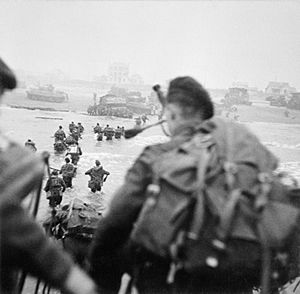
The attack on Sword Beach started around 3:00 AM with bombs from planes and shells from naval ships. These targeted German defenses and artillery. At 7:25 AM, the first units headed for the beach. These included the special DD tanks, followed by infantry and engineers.
The engineers used unique vehicles, nicknamed 'Hobart's funnies', to clear mines and obstacles. They worked under constant enemy fire. The resistance on the beach was strong at first, with many vehicles damaged. But once most of their tanks landed, the British quickly secured the area. By 9:30 AM, seven of the eight exits from the beach were clear, allowing troops to move inland.
British and French commandos faced tough fighting in the town of Ouistreham on the eastern end of Sword. They managed to clear out enemy strongpoints. By 1:00 PM, the 1st Special Service Brigade reached the bridges over the River Orne and the Caen Canal. Here, they met up with paratroopers from the 6th Airborne Division, who had secured the bridges earlier.
On the western side of Sword, commandos from the 4th Special Service Brigade moved towards Lion-sur-Mer. They planned to meet Canadian forces from Juno Beach. However, they met strong resistance and were held back by heavy fire for hours.
Around the main landing area, the 3rd Infantry Division secured Hermanville-sur-Mer by 10:00 AM. But they found it harder to advance inland towards Périers Ridge. More men, vehicles, and equipment arriving on the beach caused congestion. It became clear that the British would not be able to meet the Canadian division or immediately attack Caen.
Troops of the King's Shropshire Light Infantry pushed down the road towards Caen. They reached Biéville-Beuville, close to the city. But they had little support and their sides were open to attack. In the afternoon, the 21st Panzer Division, based near Caen, launched the only major German counter-attack of D-Day.
German Counter-Attacks
The 21st Panzer Division had many powerful Panzer IV tanks. It was meant to be a quick response force. However, its commander was away, and orders for a counter-attack were delayed until late in the day.
Around 5:00 PM, the Germans launched two attacks. The eastern attack aimed to destroy the 6th Airborne Division's bridgehead over the Orne River. But intense Allied air attacks and naval gunfire quickly stopped it.
To the west, a larger tank group did better at first. They used the gap between the Sword and Juno sectors. Parts of the 192nd Panzergrenadier Regiment reached the coast at Lion-sur-Mer by 8:00 PM. But with little air support, they also suffered losses from Allied planes. When 250 gliders carrying British reinforcements flew over their positions, the Germans thought they were about to be cut off and retreated.
The German air force was very weak in this area. However, they tried to support the attack with a few daylight flights on D-Day. German bombers attacked British positions with special "Butterfly Bombs" and bombed ships near the Orne River. British planes intercepted them and shot down five German aircraft.
|
See also
 In Spanish: Playa de Sword para niños
In Spanish: Playa de Sword para niños


